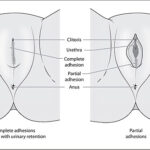Labor pain is the discomfort and cramping sensations experienced during childbirth, caused by uterine contractions and cervical dilation. It is a natural process that signals the onset of delivery, varying in intensity from mild discomfort to severe pain depending on the individual.

Causes of Labor Pain
- Uterine Contractions: Rhythmic tightening of the uterus to facilitate childbirth.
- Cervical Dilation: The gradual opening of the cervix, leading to increased pressure.
- Stretching of Birth Canal: Expansion of vaginal and perineal tissues.
- Hormonal Changes: The release of oxytocin and prostaglandins intensifies contractions.
Stages of Labor Pain
First Stage: Early & Active Labor
- Begins with mild contractions lasting 30–60 seconds.
- Pain intensifies as contractions become stronger and more frequent.
- Cervix dilates up to 10 cm.
Second Stage: Delivery of Baby
- Intense pressure in the pelvic area.
- Stronger and longer contractions aiding in pushing the baby out.
- Burning sensation as the baby’s head crowns.
Third Stage: Placental Delivery
- Mild cramping as the placenta is expelled.
- Relief from intense pain, but lingering contractions persist.
Pain Management Techniques
Non-Medical Pain Relief
- Breathing Exercises: Techniques like Lamaze and Bradley reduce pain perception.
- Water Therapy: Warm baths ease tension and provide relaxation.
- Massage & Counterpressure: Helps in reducing muscle stress.
- Movement & Positioning: Walking and squatting facilitate labor progress.
- Aromatherapy & Music: Enhances comfort and relaxation.
Medical Pain Relief Options
- Epidural Anesthesia: Most effective in numbing pain from the waist down.
- Spinal Block: Quick relief for C-sections and complicated deliveries.
- Opioid Analgesics: Short-term pain relief via IV injections.
- Nitrous Oxide: Inhaled gas providing moderate pain relief without full sedation.
Natural vs. Medicated Birth: Pros & Cons
| Method | Pros | Cons |
|---|---|---|
| Natural Birth | No medication side effects, faster recovery | More intense pain, prolonged labor |
| Epidural | Significant pain relief, reduces exhaustion | May slow labor, risk of low blood pressure |
| Spinal Block | Quick effect for C-sections | Temporary numbness, potential headaches |
| Opioids | Moderate pain relief | Possible nausea, drowsiness |
| Nitrous Oxide | Easy to administer, minimal side effects | Less effective than an epidural |
Tips to Reduce Labor Pain Naturally
- Stay Hydrated & Eat Lightly – Prevents fatigue and boosts energy.
- Practice Relaxation Techniques – Guided imagery and meditation ease stress.
- Use a Birth Ball – Encourages optimal fetal positioning.
- Get Support – Having a partner or doula can improve comfort levels.
- Opt for Warm Compresses – Helps relieve lower back pain.
Labor pain is an inevitable part of childbirth, but various management strategies can help alleviate discomfort. Whether opting for natural pain relief or medical interventions, understanding the stages of labor and available options ensures a smoother and more informed birthing experience.

